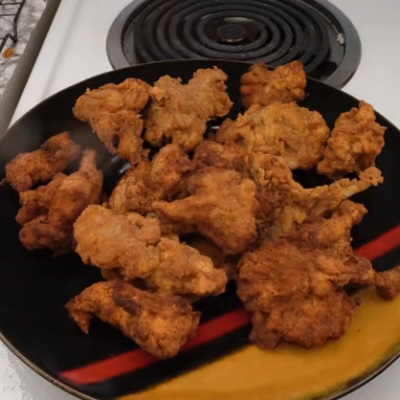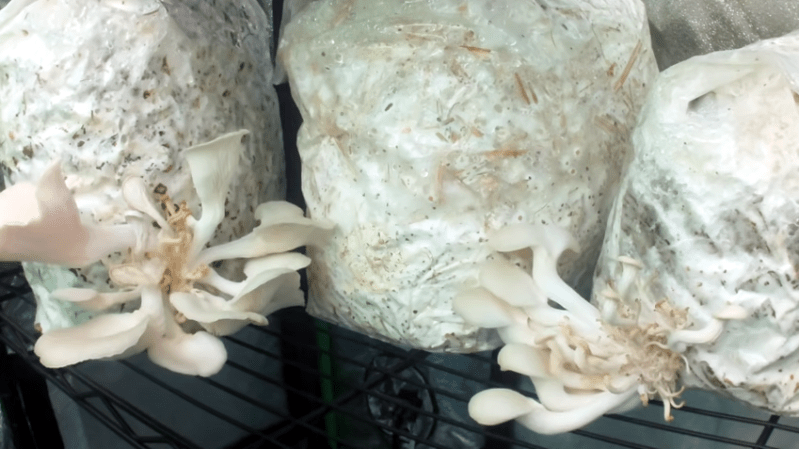[Kyle Gabriel] knows mushrooms, and his years of experience really shine through in his thorough documentation of an automated mushroom cultivation environment, created with off-the-shelf sensors and hardware as much as possible. The results speak for themselves, with some delicious fried oyster mushrooms to show for it!

The most influential conditions for mushroom cultivation are temperature, humidity, and CO2 concentration, and to automate handling the environmental conditions [Kyle] created Mycodo, an open-source system that leverages inexpensive hardware and parts while also having the ability to take regular photos to keep an eye on things.
Calling [Kyle]’s documentation “comprehensive” doesn’t do it justice, and he addresses everything from setting up a positive pressure air filtration system for a work area, to how to get usable cultures from foraged mushrooms, all the way through growth and harvesting. He even includes a delicious-looking recipe for fried mushrooms. It just doesn’t get more comprehensive than that.
We’ve seen [Kyle]’s earlier work before, and it’s fantastic to see the continued refinement. Check out a tour of the whole thing in the video embedded below (or skip to 16:11 if you want to make yourself hungry.)
















The combination of skills (microbiology, woodworking, electronics, software engineering) that this person master to turn this project into a reality is nothing short of astonishing. Really great project.
Not that hard. You don’t actually need most of that. The most important thing is being as sterile as possible, and you only need a still air box made from a big plastic tub to accomplish that. Of course, that having better equipment than just a tub increases your chances, but it’s not needed.
I don’t believe he’s talking about growing mushrooms, but the set of skills the youtuber shows on the video.
Check out “The Mushroom Cultivator” by Paul Stamets
Enokitake is often simpler to grow in mason jars… super good for hot-and-sour soups.
As a side note, Mr Gabriel’s video leaves out some pretty important safety measures.
…like don’t use shredded print/cardboard or pesticide treated timber in growing media.
…or attempt to identify mushrooms as an amateur (people die from organ failure if they get it wrong)
If you are interested in farming foods, go to Stamets website for genetically clean and identified Cultures.
He’s an odd dude, but is quite knowledgeable. =)
https://fungi.com/collections/in-vitro-mushroom-cultures
I’m not certain there’s much wrong with using the cardboard found commonly around. It’s mostly printed using soy based inks if I am not wrong.
Can you please cite toxic components and things that state that mushrooms, in particular pleurotus uptakes the toxic components?
I only say this as I have cultivated them on a wide variety of recycled paper products from phone book middles to cardboard to waste grain, etc. and I have not noticed mutations or issues and I could find no data on it being bad for the fruiting bodies or us eating them.
So I would welcome new data so I can update my practices and be more healthy.
“Can you please cite toxic components”
That would be a lifelong commitment, as fungi have an intimate relationship with most living things throughout their life-cycle. In general, some types will accumulate metals in the fruiting body, while others may not always exhibit such properties. The journals have many studies that catalog such things, and I highly recommend reading up on your specific Culture’s genetic history.
Many fungi have a unique ability to breakdown complex pollutants into nutrients, as noted in numerous site reclamation studies. The issue is mainly how fungi quickly evolve to exploit niche parts of the ecosystem… some are documented interacting with petroleum, metal salts, and even Alpha radiation on Chernobyls old reactor. What is a nutrient or byproduct to one fungi, is not always edible or safe for mammals. For example, even the common oyster mushrooms will go after polychlorinated biphenyls in the soil.
I found it a very interesting hobby, next time add 10% old coffee grounds or cocoa powder to one of your growing medias. One should be able to detect a subtle yet distinct difference in most edible varieties.
Probably should avoid glues, dyes, coatings, pressure-treated woods, warehouse-pallet insecticides, and home construction wastes like flooring or drywall. ;-)
@Nath said: “The combination of skills (microbiology, woodworking, electronics, software engineering) that this person master…”
Really, “microbiology”? Try this on instead:
Mycology [1] is the branch of biology concerned with the study of fungi, including their genetic and biochemical properties, their taxonomy and their use to humans as a source for tinder, traditional medicine, food, and entheogens, as well as their dangers, such as toxicity or infection. A biologist specializing in mycology is called a mycologist.
1. Mycology
https://en.wikipedia.org/wiki/Mycology
A) This is gross, awesome and impressive but still gross.
B) This seems like something the “mushroom leather” company would want to do. https://www.theguardian.com/science/2021/dec/02/californian-firm-touts-mushroom-leather-as-sustainability-gamechanger
Mushrooms aren’t that bad. Especially the magic kind. :-D
They are still nasty, despite the effects
Excellent execution and instructions, very well done.
Dissapointed. I looked at the image and thought they were wings. Now i’m hungry for wings. False advertisement!
kinda made me wonder how battered fried mushroom taste like… never had the pleasure of trying something like that….
very popular pub fare in the 70s and 80s. Usually served with a simple horseradish cream dipping sauce.
I don’t know why they went out of vogue.
Fried mushrooms are the best. Good job on all of this.
My local chip shop sells them. Battered and threaded on a skewer. They’re chestnut mushrooms and are delicious. I bet oysters are even better.
You should try mushrooms prepared by someone who knows them. There are a lot of varieties of edible mushrooms. Some have a stronger flavor than others. Overcooking tends to destroy (grossify) most any food. Not all all musshrooms are interchangable in recipes. Some are better eaten raw. The main appeal of mushrooms, is they make a decent replacement for meat protien. The have high nutritional value, which is good to understand, if you are running low on foods. Most don’t bother learning about mushrooms, or rely on the experence of others. Some wild mushrooms aren’t ‘safe’, so not many want to take the time to learn, just avoid them all.
The book “How to Survive in the Woods”, cautions readers not to waste energy hunting for mushrooms. Even safe ones do not supply enough energy to compensate for the energy used in hunting them.
Surely that is a stupid way to look at it, if you are foraging and know what mushrooms are good (or at least safe) to eat it is the work of a moment so short its hardly going to break your stride as you go past to gather it… So its damn nearly free energy. The key to all foraging is being attentive and knowledgeable enough to spot the edible stuff, you are never ‘hunting’ just x to the point you would pass up y, even more so in a survival situation.
The advice to avoid shrooms is one I can support, I know there are only a tiny number of nice shrooms I would be 100% confident of the identification of around here and would avoid all the others even when I am somewhat sure, I have no wish to really master the art of identifying them all (far to much work and never enough time) and some good eaters are very similar in appearance to nasty ones, so why risk that sort at all…
Great project. I’ve contemplated doing that myself. But in the end, it is not necessary. You can grow tons and tons of mushrooms without the need of all that automation in a big 60+ quart tub, or two depending on how much you want to harvest at a time.
What is receipe for frying? Do you use butter or olive oil, cracker or bread crumbs. Look delicious… Thank you
But where’s the part about growing fried mushrooms?
How satisfying is it to you to put down other peoples work, especially when they excel at the technical aspects and make their knowledge available to many others, at no cost? I keep trying to find a reason not to simply dismiss people like you as worthless naysayers who have nothing to bring to the statement, but really, that’s all I can see that you are.
IMHO…Usually (at least in the US & UK), they taste like greasy mushrooms, with a greasy coating of soggy fried dough.
In Japan & Korea, they have tempura fried mushrooms, which are divine.
I’ve recently learned of using alcohol to prevent gluten formation in batter so you can really get some crispy thin crust. also will have some mushrooms ready to harvest soon 😀
You have my attention…
I now have…. The Hunger.
Mushroom phorid fly infestations are worse than fruit flies. They’re about the same size as a fruit fly, reproduce like crazy, and they are hard to kill.[1]
Excerpting [2]: Megaselia halterata, the mushroom phorid, is a pest of mushroom cultures. Although it does not cause direct damage (wrong, it does), it is an efficient vector of dry mould (Lecanicillium fungicola).”
From [1]: “Mushroom phorid flies are pests of mushroom crops. The adult flies are short-lived and do not eat. The life cycle of a phorid fly has four distinct life stages: egg, larva, pupa, and adult. The adult stage is short-lived–they mate, lay eggs, and die. Adult flies do not feed, although they need high humidity to survive. Mated adult females lay eggs in mushroom compost with well-developed mycelium. The larvae hatch from the eggs within a few days and feed on the actively growing mycelium; this is the only life stage that actually feeds. The larvae pupate in the compost, and adult flies emerge approximately 20 to 30 days after the eggs were laid.”
Yeah, so when you harvest mushrooms you cut the stems and take what is above the compost The larvae hatch and feed on the mushroom parts embedded in the compost. But the mushrooms are still harmed. The feeding larvae vector fungal diseases to the mushrooms, and feeding directly on the mushrooms harms them too. Crop yields are lower during phorid fly infestations. Using compost balls and cutting slits in the plastic where the caps emerge probably helps to deter the phorid flies by making harder for them to reach the compost. But commercial mushroom growers do the same/similar thing yet they still have problems with mushroom phorid flies.
[Kyle Gabriel] should automate a way to eradicate mushroom phorid flies because sooner or later, they’re probably gonna show up. IMO ML-driven binocular-vision equipped mini laser turrets that zap the flies mid-flight before they get anywhere near the compost is the way to go.
1. Mushroom Phorid Fly Infestations in Mushroom Farms and Surrounding Neighborhoods:
https://extension.psu.edu/mushroom-phorid-fly-infestations-in-mushroom-farms-and-surrounding-neighborhoods
2. Phoridae:
https://en.wikipedia.org/wiki/Phoridae
thanks dude, look great and full of inspiration
How dangerous is this? What are the odds of getting a poisonous variety.